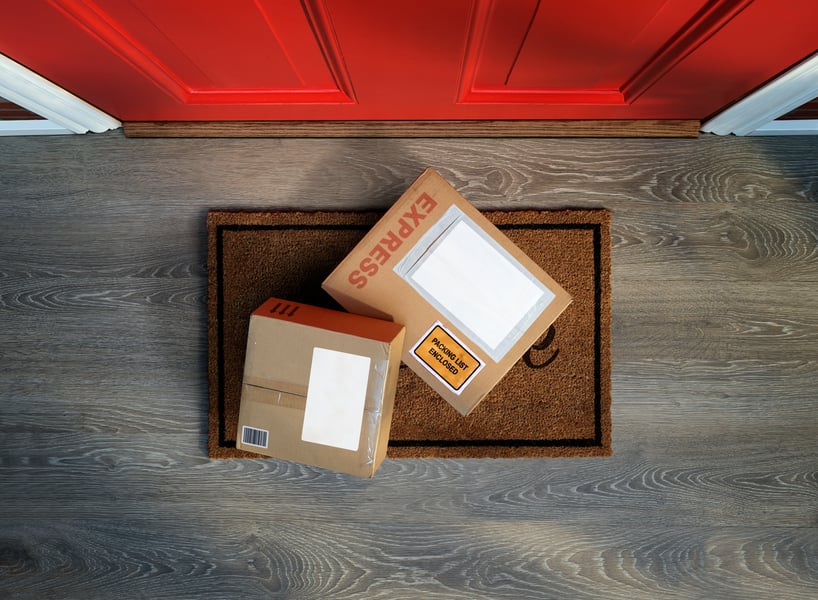Package Theft and Porch Pirates: How Retailers Can Combat this Growing Threat
Retail
As e-commerce continues to grow as a major channel for retailers, a new form of theft has grown with it: “porch piracy” or package theft. Studies estimate that porch pirates stole somewhere between $8 billion to almost $20 billion in retail merchandise, with the numbers growing every year.
In this article, we explore why package theft is rising, how it’s impacting retailers, and current legal changes happening as a result. We’ll also explore why porch piracy and e-commerce fraud presents a unique challenge to Loss Prevention (LP) teams and the strategies they can use to combat this growing source of loss.
What Are Porch Pirates?
Porch pirates are individuals or groups who steal packages from outside a customer’s delivery location (usually their home, outside the entrance, and you guessed it, typically off their porch!), usually soon after they have been delivered by the postal service or last-mile carrier. Porch piracy is the most common (but not only) form of package theft.
Porch piracy is often opportunistic and requires little to no planning, making it attractive to petty criminals. The typical modus operandi of a porch pirate involves waiting for a delivery person to leave a package on a doorstep and then swooping in to snatch it when the coast is clear. They often target homes during the day when residents are likely to be at work or out running errands.
Some porch pirates follow delivery trucks around neighborhoods, waiting for the perfect opportunity to strike. Others might casually stroll or drive through neighborhoods looking for unattended packages. In some instances, porch pirates have been known to use technology to their advantage, using apps that alert them to incoming deliveries.
The Rise of Porch Piracy and Package Theft
E-commerce has grown steadily over the past decade before greatly accelerating during the COVID-19 pandemic, now comprising around 15% of all retail sales in the US and is expected to surpass 20% by 2027. However, this shift in consumer behavior has also given rise to new forms of crime, such as porch piracy and e-commerce fraud. As more goods are purchased online and delivered to homes, package theft has surged dramatically.
Porch piracy is widespread, but just how common is a matter of debate. A 2023 survey by the Chamber of Commerce found that 26% of respondents have been a victim of package theft, with an average value of $81.91 per stolen package, while a study by Safewise found that 79% of Americans were targeted by porch pirates in 2022. The same study found that 260 million delivered packages were stolen in 2022, up from 210 million packages the year before.
It’s also growing, especially around high-profile sales events and the holiday shopping season. According to Retail Dive, package theft increased by 47% in November 2022, with porch package thefts rising to an astonishing 87% in December compared to 2021. The aftermath of Prime Day, a major sales event by Amazon, saw an alarming rise in package theft of approximately 40% according to Security.org
Why is porch piracy so attractive to criminals and growing in severity? It's a low-risk, high-reward activity. The chances of getting caught in the act are relatively low, especially if the thief strikes when the homeowner is away. The rise of online shopping means there's an abundance of packages being delivered daily, providing plenty of opportunities for theft. The contents of packages can often be valuable, ranging from electronics to clothing to household goods, and can be easily sold online for a profit. And the lack of stringent penalties for package theft in many jurisdictions also contributes to the problem, as the potential rewards far outweigh the risks.
The rise in online shopping, while beneficial for consumers and businesses in many ways, has unfortunately led to a dramatic increase in package theft. This growing problem poses significant challenges for retailers, who must find effective strategies to combat porch piracy and ensure their customers receive their purchases safely.
Legal Changes to Combat Porch Piracy
Package theft is almost always considered a minor crime unworthy of investigation by police. In most circumstances, once a package is delivered the resident is considered the victim of a theft, but it’s retailers (and sometimes delivery companies) that need to provide refunds and replacements.
However, frustration with the growth and impact of porch piracy has led to new bills being introduced across the US to increase criminal penalties. As of 2023, eight US states have elevated package theft from a misdemeanor to a felony: Texas, Michigan, Oklahoma, Arkansas, Tennessee, Georgia, Kentucky, and New Jersey. California, New York, South Carolina, Kansas, and Missouri all have similar laws drafted and pending passage through state legislatures.
At the federal level, the Porch Pirates Act is pending in Congress. Introduced by U.S. Rep. Dean Phillips, D-Minn, in May 2022, this measure would apply the same penalties to the theft of packages delivered by shippers such as Amazon, FedEx and UPS as are applied to U.S. Postal Service mail. Under federal law, stealing a package delivered by the Postal Service is a felony punishable by up to five years in prison and a $250,000 fine.
The Impact of Package Theft on Retailers and Loss Prevention Professionals
The financial implications of porch piracy are significant for retailers. When packages are stolen, retailers often bear the cost of replacing the stolen goods, which can be substantial, particularly for high-value items.
If a customer orders a $200 electronics item that gets stolen from their porch, most retailers will replace that item at their own expense. This means the retailer not only loses out on the profit they would have made from the original sale, but they also incur additional costs to replace and re-ship the item.
In addition to the direct costs associated with replacing stolen goods, retailers also face indirect impacts such as the potential loss of customer trust. When a customer's package is stolen, it can lead to a negative shopping experience, even though the theft is not the fault of the retailer. This negative experience can lead to a loss of trust in the retailer, which can be difficult to regain. Furthermore, disappointed customers might share their negative experiences on social media or review sites, potentially deterring other customers from shopping with the retailer.
This is why retailers will eat the cost to ship a replacement at no cost to the customer. But with e-commerce costs already dragging down retail profitability, retailers need to take actions to reduce sources of e-commerce loss such as package theft and order claims.
The Challenge for Loss Prevention
Traditional loss prevention methods, such as in-store surveillance cameras, security tags, and store personnel, are not effective against package theft. This is because porch piracy occurs off-premises, outside the retailer's direct control and far away from the physical store.
This off-premises aspect of package theft presents unique challenges. For one, retailers can't monitor every customer's doorstep the way they can monitor their own stores. The responsibility for the package shifts to the delivery service once it leaves the retailer's premises; however, the retailer usually bears the brunt of the customer's frustration if a package is stolen. Also, in-house LP teams may not have access to internal e-commerce data, with the loss and shrink happening through e-commerce completely out of their reach.
Another challenge is the sheer scale of the problem. With the rise of online shopping, millions of packages are delivered to doorsteps across the country every day. For large retailers, monitoring all these deliveries and ensuring they reach customers safely is just too big a logistical challenge to try to handle manually.
Local law enforcement agencies often struggle to prioritize package theft due to more pressing criminal activities. While some jurisdictions have increased penalties for package theft, enforcement remains problematic. Porch pirates can be difficult to catch in the act, and even when they are, they often face minimal consequences, especially for first-time offenses. Porch pirates typically strike quickly and leave little evidence behind, making it difficult for law enforcement to track them down. They also tend to operate in areas where they're not likely to be recognized, further complicating efforts to identify and apprehend them.
The unique challenges of preventing package theft and porch piracy call for innovative LP strategies. Retailers need to explore new technologies and partnerships to protect their goods and ensure a positive shopping experience for their customers.
Strategies to Combat Package Theft
As the problem of porch piracy continues to grow, retailers, delivery services, and consumers are exploring new strategies to combat package theft. Because the site of the theft happens on or just outside the customer’s address rather than in-store, most of the prevention methods fall on the customer.
According to a study in Criminal Justice Studies, traditional Situational Crime Prevention (SCP) practices such as fences, cameras, and guardians or people appearing to be home have little impact on porch pirates. Frustrated consumers have attempted such measures as rigging decoy parcels with glitter bombs, low-grade explosives, blank round firing mechanisms, and animal feces in an effort to deter thieves.
Obviously, better options are needed.
One such option is limiting delivery to more secure options such as:
- In-store Pickups: Many retailers offer in-store pickup options. Customers can order online and then pick up their items at a local store, ensuring their packages aren't left vulnerable on their porches.
- Locker Pick-ups: Amazon, for instance, offers Amazon Locker, a self-service kiosk where customers can pick up their packages at a time that's convenient for them. This eliminates the risk of leaving packages unattended on doorsteps. For retailers without lockers or nearby retail locations, packages can be picked up from a location of the last-mile delivery carrier.
- Secure Delivery Boxes: Some companies sell secure delivery boxes that homeowners can install on their properties. Delivery drivers can place packages inside these locked boxes, protecting them from thieves.
Technology can also play a significant role in deterring porch pirates, most notably security cameras. Home security cameras, such as those offered by Ring or Nest, can capture footage of porch pirates in action. This footage can help law enforcement identify and catch the thieves. It also acts as a deterrent; thieves may be less likely to steal a package if they know they're being recorded.
However, these put most of the onus on the customer, and are either out of control of the retailer or create an additional hassle for the customer (such as forcing pickup from a store location), making them incomplete solutions.
Make Better Decisions with Data
While you can’t perfectly control package theft, you can gain visibility into where, when, and how claims are happening and use that data to make better, cost-savings decisions about your operations.
Issues with shipping carriers and vendors and claims of theft by porch pirates can present nuanced problems for retailers requiring a fine balance between customer satisfaction and profitability. Many LP teams don’t have access to e-commerce data, leading to missed opportunities for shrink reduction. Higher thresholds for addressing online fraud and the risk of losing customer business deter organizations from seeking assistance in resolving e-commerce issues.
Agilence’s eCommerce Module provides powerful insights into a wide range of e-commerce metrics, including sales, returns, customer behaviors, and more. The module also reconciles inventory for in-store and digital channels and analyzes shipping patterns to identify areas of concern.
The Shipping Analysis enables users to identify problematic shipping addresses and areas with a high number of claims and returns. Problematic addresses may include locations with frequent delivery issues, which can lead to customer dissatisfaction or lost revenue due to undelivered orders. By understanding areas with high claims and returns, users can optimize their shipping processes, choose the right carriers, and implement strategies to reduce losses. Improving the accuracy and reliability of shipping operations enhances the overall customer experience and minimizes the financial impact of shipping-related issues.
Learn more about the eCommerce Module.
Related Articles
Why Flash Mob Theft Has Become a Viral Crime
The term "flash mob" in the viral sense is typically attributed to videos at weddings or on the streets of people uniformly b...
The Real Impact of Rising Felony Shoplifting Thresholds on Retail
You’ve seen the pictures of brazen thefts in retail stores, from violent flash mobs to the Walgreens’ bike-riding shoplifter....
12 Holiday Loss Prevention Strategies to Protect Your Retail Store
The holiday season is a whirlwind for retailers—a time of bustling stores, eager shoppers, and soaring sales. But with all th...Subscribe to our blog
Receive free educational resources like exclusive reports, webinars, and industry thought leadership articles straight to your inbox.

